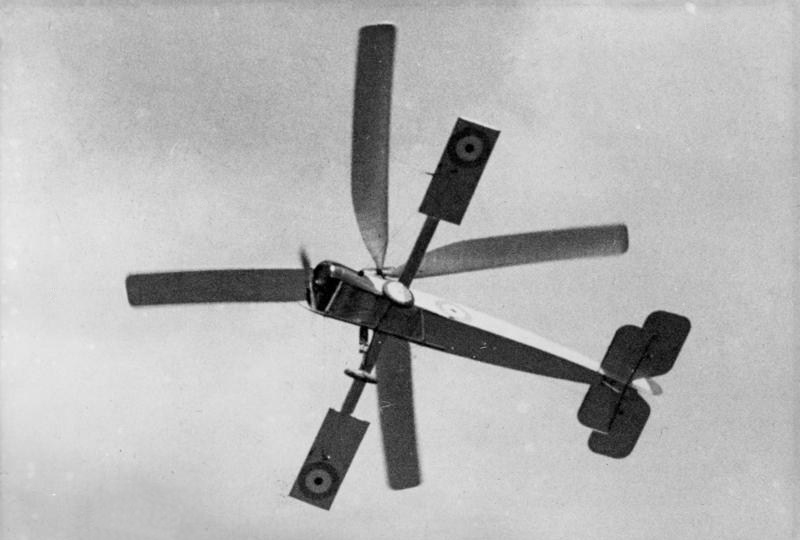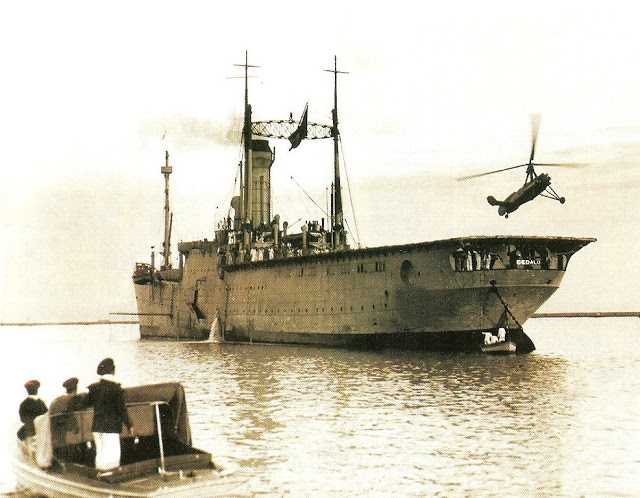The Cruel Sea:
The Cierva C.30
by Mike Bennighof, Ph.D.
November 2022
 In the Second Great War alternative history, I wanted the secondary world background to be unique, so that the game wouldn’t just have different-colored pieces. The technology would need to be close enough to our own reality that combat and operations played out similarly to those of Second World War at Sea, and close enough so we didn’t need a new rulebook. I also wanted it based, as much as possible on “real” developments that just didn’t catch fire for one reason or another. In the Second Great War alternative history, I wanted the secondary world background to be unique, so that the game wouldn’t just have different-colored pieces. The technology would need to be close enough to our own reality that combat and operations played out similarly to those of Second World War at Sea, and close enough so we didn’t need a new rulebook. I also wanted it based, as much as possible on “real” developments that just didn’t catch fire for one reason or another.
And so every participant in Second Great War at Sea: The Cruel Sea operates helicopters (and one autogyro), all of them machines that actually existed at least in prototype form, several of which saw serial production.
One of the key differences in our counter-factual is the primacy of rotary flight over fixed-wing aircraft. That includes both helicopters and autogyros. An autogyro looks a great deal like a helicopter, but the physics are not nearly the same. The rotors turn freely – they’re not connected to the engine – and provide lift instead of wings. The aircraft’s power comes from a propeller, just like that of an airplane. They enjoy the same high degree of maneuverability as a helicopter, and while they can’t quite hover except in a headwind (at least some air has to flow over the rotor to maintain lift) they can operate at very low speeds, achieving a similar effect. That made them potentially useful for several military missions: anti-submarine warfare and mine-hunting at sea, and artillery spotting on land.
 Spanish engineer Juan de la Cierva developed the autogyro in his quest to build an airplane that could operate at low speeds without stalling. The work began in 1910, when he was 15 years old and helped found a company to build conventional airplanes. One of their early prototypes crashed due to low airspeed, and Cierva considered how to build a plane that would be safe at slow speeds. Spanish engineer Juan de la Cierva developed the autogyro in his quest to build an airplane that could operate at low speeds without stalling. The work began in 1910, when he was 15 years old and helped found a company to build conventional airplanes. One of their early prototypes crashed due to low airspeed, and Cierva considered how to build a plane that would be safe at slow speeds.
Inspired by a child’s toy, he began to experiment with a plane that replaced the wings with a rotor. He noodled around with the concept during his university years, and by 1920 he had a prototype ready to be patented. At the same time, he filed for a trademark on the term “autogyro.” His first prototypes got off the ground, but experienced rough flights thanks to unstable lift. One night at the opera, Cierva had an insight – if the rotors were flexible, the machine would fly smoothly.

The C.6 autogyro in flight.
With joints added at the base of the rotors, the next prototype, the C.4, performed as Cierva had imagined. He took his aircraft on tour, making a good impression on the British Air Ministry, and in 1926 Scottish industrialist James Weir and the aircraft firm Avro joined him in a new British-based venture to build autogyros. He continued to refine the design, and a major breakthrough came with the C.19 in 1929, which allowed the pilot to control the rotor. Avro built 30 of them in the U.K. while Focke-Wulf produced a licensed version in Germany and Loiré-et-Olivier bought another license to build them in France but did not actually commence production.
The C.30 flew in 1933, and became the most successful of the Cierva aircraft. It featured direct control of the rotor, finally allowing the aircraft to easily fly at very slow speeds. Avro built it in the U.K., Focke-Wulf in Germany and Loire et Olivier in France. Modified licensed copies appeared in Japan and the United States as well. Cierva himself landed an Avro-built model on the Spanish Navy seaplane tender Dedalo in 1934 and took off again.

Taking off from Dedalo. 7 March 1934.
The C.30 was slow, by design, with a range of about 450 kilometers. Neither of those was particularly important to its designer or its operators – it job was to move at a very slow speed, observing targets on the ground (in its artillery-spotter role) or under the sea (in its anti-submarine configuration). It carried just a pilot (the improved C.40 added an observer) and, when the jump-start feature of the C.40 was added (as was done with some machines), it could take off with a very brief starting run.
An improved model, the C.40, appeared in 1938, delayed by problems with its engine, but by then Cierva’s death in an airliner crash in the Netherlands in December 1936 had ended the aircraft’s development. A staunch supporter of Francisco Franco, he’d played a key role in Franco’s escape from exile in the Canary Islands and become active in the Nationalist cause.
The Royal Air Force used its autogyros to calibrate radar stations, but real military use began (and pretty much ended) with the Imperial Japanese Army, which deployed the Ka-1 (a licensed copy of the C.30) as an artillery spotter and then for anti-submarine work from the Army’s two escort carriers (yes, the Japanese Army operated aircraft carriers). The French Navy ordered 65 of them, but seem to have made little use of them. The Germans captured most of these aircraft in 1940. But likewise did not actively deploy them.
Very few of the craft survived the war; they appear to have been rather fragile. A few continued in civilian use until the 1950’s, and some survive in museums. Autogyros, now usually powered by a small jet engine, continue to have a following in this century.
The autogyro first appeared in Second World War at Sea games in the long out-of-print Leyte Gulf; Japanese Ka-1 aircraft flying from the two Army escort carriers. We included British versions in one of the older Golden Journals (and Austro-Hungarian ones, just because). A Panzer Grenadier version of the Ka-1 appeared in the old Secret Weapons book.

RAF officers examine a C.30 used for Army cooperation.
The C.30 (actually the license-built Focke-Wulf Fw.30 Heuschrecke, or “Grasshopper”) appears in The Cruel Sea, in some scenarios operated by German helicopter carriers. The German Navy did not actually deploy any of them at sea, but that doesn’t stop us from using them in our alternative history. In game terms they’re “helicopters,” even though they’re actually a different class of aircraft. They’ll show up again in other games and expansions, in some of their other forms.
You can order The Cruel Sea right here, right now.
Sign up for our newsletter right here. Your info will never be sold or transferred; we'll just use it to update you on new games and new offers.
Mike Bennighof is president of Avalanche Press and holds a doctorate in history from Emory University. A Fulbright Scholar and NASA Journalist in Space finalist, he has published a great many books, games and articles on historical subjects; people are saying that some of them are actually good.
He lives in Birmingham, Alabama with his wife and three children. He will never forget his Iron Dog, Leopold.
Want to keep Daily Content free of third-party ads? You can send us some love (and cash) through this link right here.
|
